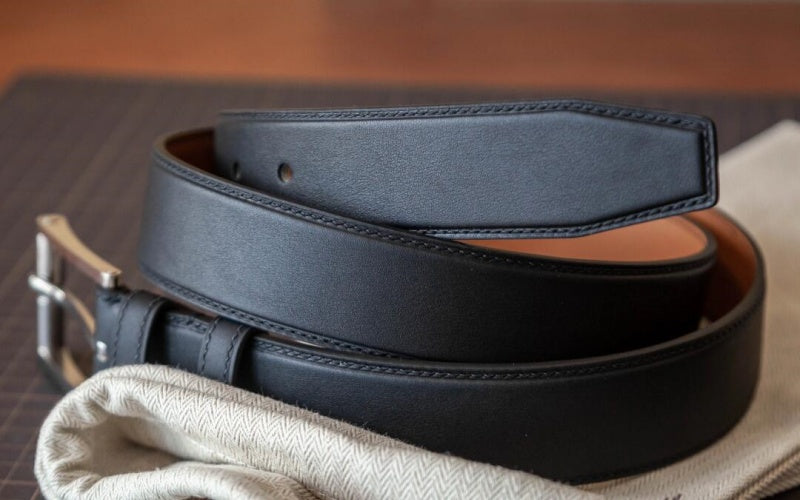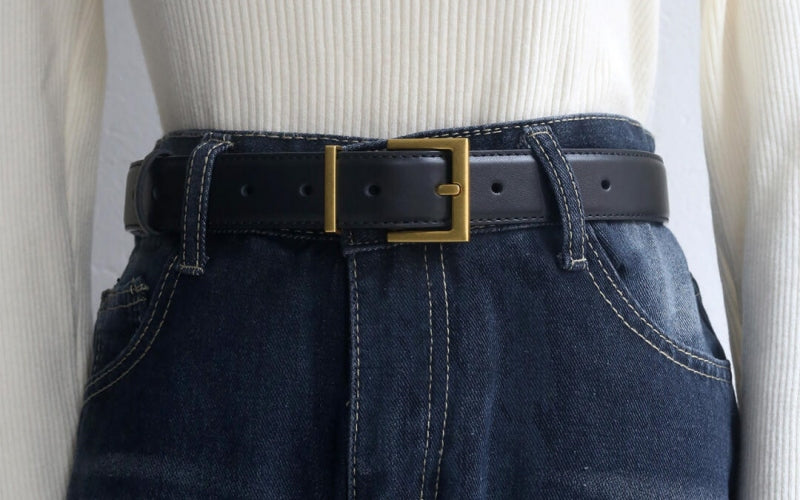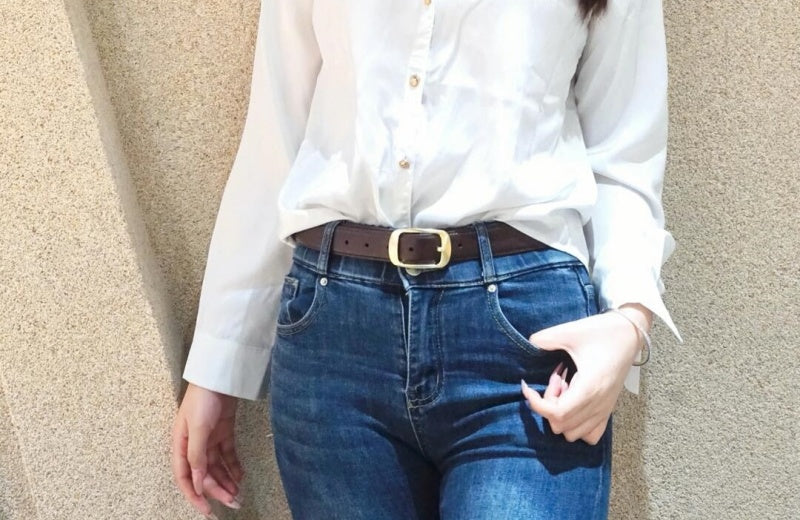
Is Top Grain Leather Real Leather? (Yes, But You’re Being Bamboozled)
Let’s cut through the bovine BS: You’re shopping for a leather belt, jacket, or couch, and you keep seeing the term “top grain leather” thrown around like confetti at a parade. The salesperson swears it’s “the best quality,” but your gut says, “Wait…is top grain leather even real leather?”
Short answer: Yes, top grain leather is real leather. But here’s the kicker: So is the hot dog you ate at the baseball game. The real question is: What kind of leather are you actually getting?
Buckle up (pun intended), because we’re diving into the messy, fascinating world of leather grading, marketing myths, and why your “luxury” top grain couch might be one spilled margarita away from ruin.
 Obsessed with this belt? Find its full grain twins — tap the pic.
Obsessed with this belt? Find its full grain twins — tap the pic.
1. What is Top Grain Leather? (The “Middle Child” of Leather)
A. The Leather Layer Cake
Imagine a cowhide as a layered cake:
-
Full-Grain: The top layer, untouched and natural (think: rich, imperfect, and durable).
-
Top Grain: The same top layer, but sanded and polished to hide flaws (like Instagram vs. reality).
-
Genuine Leather: The middle layers, chopped up, glued, and stamped with a fake grain pattern (the hot dog of leather).
-
Bonded Leather: Pulverized scraps mixed with plastic (the “mystery meat” of the leather world).
B. How Top Grain Leather is Made
-
Step 1: The hide is split. The top layer becomes full-grain; the layer beneath becomes top grain.
-
Step 2: Sandblasting or buffing removes natural imperfections (scars, insect bites, stretch marks).
-
Step 3: A synthetic coating (usually polyurethane) is applied to create a uniform look.
-
Step 4: Embossing adds a fake grain pattern. Voilà—perfection! (But at what cost?)
C. The Marketing Mirage
Top grain is often labeled “genuine leather,” but not all genuine leather is top grain. Confused? That’s the point. Retailers bank on your confusion to upsell mid-tier products as “premium.”
Obsessed with this belt? Find its full grain twins — tap the pic.
2. Is Top Grain Leather Real Leather? (Yes, But Let’s Get Technical)
Yes, top grain leather comes from real animal hides. But it’s like comparing a farm-fresh heirloom tomato to ketchup:
-
Real? Technically, yes.
-
Unprocessed? Hell no.
Why It’s Still Called “Real Leather”:
-
Legal loopholes allow any product containing leather fibers to be labeled “genuine leather”—even if it’s 10% leather and 90% glue.
-
Top grain retains some natural fibers, so it squeaks by as “real.”
3. Top Grain vs. Full-Grain Leather: The Ultimate Showdown
|
Feature |
Top Grain Leather |
Full-Grain Leather |
|
Surface |
Sanded, polished, coated |
Natural, untouched |
|
Durability |
5–10 years (with care) |
20+ years (ages like wine) |
|
Breathability |
Low (coating traps moisture) |
High (natural fibers breathe) |
|
Patina |
Develops a slight sheen |
Develops rich, unique character |
|
Cost |
$–$$ |
$$–$$$ |
|
Best For |
Mass-produced furniture, mid-tier accessories |
Heirloom pieces, luxury goods |
Real-World Example:
-
A top grain leather couch might survive your kids’ juice boxes for a decade.
-
A full-grain leather belt (like Beltley’s) will outlive your dog, your car, and possibly your marriage.
Obsessed with this belt? Find its full grain twins — tap the pic.
4. The Dark Side of Top Grain: Why “Real” Doesn’t Mean “Better”
A. The Plastic Problem
That glossy finish on top grain? It’s usually a polyurethane coating. Over time, it:
-
Cracks: Like a dried-up riverbed.
-
Peels: Revealing the sad, sanded layer beneath.
-
Traps Moisture: Leading to mold and odors (RIP, summer sweat).
B. The Durability Deception
By sanding away the dense top fibers, top grain loses:
-
Tensile strength: It tears easier than a rom-com plot.
-
Natural oils: Making it prone to drying and cracking.
C. The Environmental Impact
-
Chemicals: Top grain processing uses harsh dyes and finishes.
-
Waste: Sanded-off leather particles often end up in bonded leather (aka landfill fodder).
Obsessed with this belt? Find its full grain twins — tap the pic.
5. Top Grain Leather Myths Debunked
Myth 1: “Top Grain is Just as Good as Full-Grain.”
-
Reality: Full-grain retains the strongest, most breathable part of the hide. Top grain is Diet Coke to full-grain’s espresso.
Myth 2: “Top Grain is More Affordable.”
-
Reality: You’ll replace a top grain belt 3x before a full-grain one gives up. Math says full-grain wins.
Myth 3: “Top Grain Looks More Luxurious.”
-
Reality: That uniform shine is plastic. Full-grain’s natural marks = authentic luxury.
Obsessed with this belt? Find its full grain twins — tap the pic.
6. When to Buy Top Grain Leather (And When to Run)
A. Buy Top Grain If…
-
You need a budget-friendly option for low-use items (decorative pillows, accent chairs).
-
You prioritize a pristine look over longevity.
-
You’re okay with replacing it in a few years.
B. Avoid Top Grain If…
-
You want something durable (daily belts, boots, pet-friendly furniture).
-
You value sustainability (chemicals + short lifespan = eco-nightmare).
-
You hate the idea of plastic-coated “leather.”
Obsessed with this belt? Find its full grain twins — tap the pic.
7. How to Spot Top Grain Leather (Before You Get Scammed)
A. The Touch Test
-
Top Grain: Feels smooth, almost plasticky.
-
Full-Grain: Feels supple, slightly textured.
B. The Smell Test
-
Top Grain: Smells like chemicals or nothing.
-
Full-Grain: Smells rich and earthy (like a saddle shop).
C. The Bend Test
-
Top Grain: Stiff, creases unnaturally.
-
Full-Grain: Flexes smoothly, shows subtle grain variation.
D. The Price Test
-
Top Grain: Cheap for “real leather” (a red flag).
-
Full-Grain: Costs more but comes with warranties (like Beltley’s 15-year guarantee).
Obsessed with this belt? Find its full grain twins — tap the pic.
8. Why Beltley Bans Top Grain (And You Should Too)
At Beltley, we use full-grain leather because:
-
It’s Timeless: Develops a patina that tells your story.
-
It’s Tough: Survives spills, scratches, and midlife crises.
-
It’s Honest: No sanding, no coatings, no lies.
Compare:
-
Top Grain Belt: $40–$80, lasts 2–5 years.
-
Beltley Full-Grain Belt: $120–$200, lasts 15+ years.
Obsessed with this belt? Find its full grain twins — tap the pic.
9. FAQs: Your Top Grain Questions, Answered
Q: Is top grain leather waterproof?
A: The coating resists spills temporarily, but once it cracks, all bets are off.
Q: Can top grain be repaired?
A: Only superficially. Sanded layers can’t be restored.
Q: Does top grain come from cows?
A: Usually, but it can also be pig, sheep, or even kangaroo (no joke).
Q: Is Bonded Leather Real Leather?
A: Technically yes, but it’s the fast food of leather—cheap, greasy, and regrettable.
Obsessed with this belt? Find its full grain twins — tap the pic.
10. The Final Word:
Top Grain is Real… But Real What?
Top grain leather is real in the same way a spray tan is real color—technically true, but missing the essence. If you want leather that’s authentic, durable, and sustainable, skip the sanded, coated imitators and invest in full-grain.
Ready to Ditch the Imposters?
Shop Beltley’s Full-Grain Collection Here—where “genuine” means genuinely exceptional.








